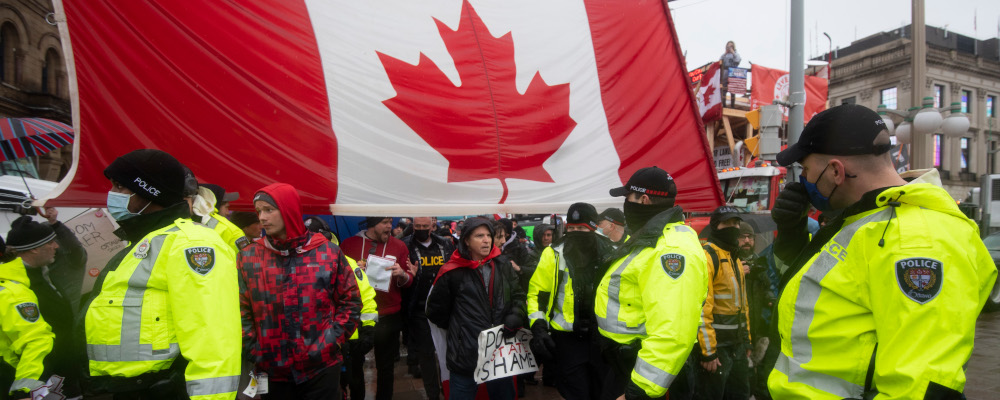A year ago, the Convoy rolled into Ottawa. I’ve long been a critic of disruptive left-wing protests. I have had a front-row seat to two of the most disruptive ones in North America where I was shocked by the lengths to which bored teenagers would go to make a point. Smashing a Starbucks didn’t seem like a reasonable way to emphasize how much you hate globalization, nor does throwing soup at paintings to express displeasure with global climate policies. So, I wasn’t exactly enthusiastic about the Convoy.
I’ll admit. I’m biased against disruptive protests. The rule of law underpins modern society. It’s like a bone inside your body: you don’t really notice it unless it breaks, but it holds things together. We live our lives every day knowing that other people will also follow the law—or at least enough of us to keep the world spinning. The idea that you can cause property damage or grind a city to a halt to make a point never made sense to me.
Needless to say, I was not pleased when the horns started. After weeks of deafening protests by truckers, I’d had enough. Honking might not seem like a big deal, but eventually, it starts to feel like torture. This was the last straw for us. We decided to move out of Downtown Toronto.
Perhaps you guessed it, but that last anecdote wasn’t about the Convoy. It was about the Indian consulate protests in 2021. Every Friday afternoon, trucks would drive through major Toronto streets slowly while wailing their horns, followed by a convoy of supporters. Dump trucks crashing their beds up and down for hours on end was the cherry on top. That sound is etched on my brain.
We lived just off Bloor Street, across from the Indian consulate. Working from home while deafening noise rattles around in your brain is enough to drive you crazy. Try doing a Zoom call when you can’t hear yourself think. It doesn’t work out so well. The only good thing I can say about the protests is that at least they were only a few hours a week. But it was more than we were willing to put up with.
We moved out of downtown in part to avoid any future protests. We lived in a high-rise building that was built to withstand street traffic. It was not built to withstand this. We figured it wouldn’t be the last protest. Sure enough, along came the Convoy. By that point, we’d left downtown. Ironically, the planned Convoy route cut through my new neighbourhood.
People who don’t live in Toronto may not realize this, but there were a tense few days when Convoy protests were planned for Toronto. People were really on edge. I bought heavy-duty earplugs. Based on the messages normally even-keeled friends of mine were sending around, I don’t think Torontonians were going to be quite as patient as Ottawans. Especially those with young children. Mercifully, the Toronto police did what the Ottawa police did not: they blocked off major streets in the downtown core to limit disruptions. So it fizzled out.
Protests are a legitimate part of democratic life. However, there are limits to what anyone will or should accept. No one is going to mind if you go to Queens’ Park or maybe the sidewalk outside of a company you’re mad at. That’s much different than shutting down a street forever because you want to make a political point.
Part of the problem with debates over the right to protest is that people romanticize the past. People seem to think they can be Martin Luther King without the Birmingham jail. Civil disobedience is no joke. If you feel strongly enough about a law that you are willing to go to jail to call attention to the injustice of the system then, well, you go to jail. The idea that people have the right to cosplay as revolutionaries and occupy a city indefinitely is utter nonsense.
For those who don’t live in urban centres, ask yourself this: how would you feel if people were allowed to park in front of your house and honk all day while also enjoying police protection? I imagine you wouldn’t like that.
There is no right to annoy people. We have bylaws. You can’t make unlimited noise in your house any more than I can open a 24-hour nightclub in a cul-de-sac. Bylaws might go too far sometimes, but we have processes to change those bylaws. You don’t get to just pick and choose which ones you like. That’s what the ballot box is for.
The unusual thing about the Convoy wasn’t the police crackdown but how long it took. Those of us who were in Toronto during the 2010 G-20 protests remember how quickly police are willing to clear the scene under most circumstances.
Things turned on a dime from marching to fleeing, then. I was chatting with one of the riot police right as the crackdown started and he abruptly turned and told me I had about thirty seconds to leave. It was too late to avoid the teargas by that point. The police might have gone too far. But at some point, protesters have to go home. Whether it was done rightly or not, the streets were cleared and life went on.

I was also at the 2009 G-20 conference in Pittsburgh (that time as a protester, not an observer). This was ten years after the infamous Battle of Seattle at the G-20 summit in 1999. The police weren’t going to let history repeat itself. I remember crossing the street while a line of armed police repeatedly tapped their shields with their batons to announce their presence. Blackhawk helicopters circled the downtown. It was clear they weren’t messing around. Our little pro-free trade group waved some signs then got out while the going was good. Unsurprisingly, it ended with teargas. By the next day, it was almost as though the protest never happened. I was just a tourist enjoying the city.
At the time of writing there is a large anti-coal protest in Germany. Celebrities like Greta Thunberg are being hauled away by police—gleefully, I’d add. They know what they’re doing. The point of a protest isn’t usually to physically shut something down. It’s usually a glorified photo op that gets sorted out by lawyers afterward. But it gets them on TV. It may be annoying sometimes, but it sorts itself out pretty quickly. Protests aren’t meant to last forever.
There’s nothing inherently wrong with protests. But there are limits. Unless there is a literal coup d’état or the Soviets roll in with tanks, disruptive protests are hard to justify. Moreover, it’s not clear that they achieve anything. Frankly, if they did, it would send a really bad message.
One of the last things we need as a society is for people to start to think that they can get what they want by smashing things or taking communities hostage. That doesn’t end well.
Recommended for You

‘A celebration of the spirit of Alberta’: Ryan Hastman on the political, economic, and cultural importance of the Calgary Stampede

Michael Geist: Children accessing porn is a problem, but government-approved age verification technologies are not the answer

Daniel Zekveld: Age verification for pornography is not government overreach

Need to Know: Yahoo, Alberta! You’re doing something right



